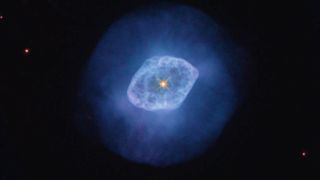Hubble telescope spots a complex cloud of gas expanding into space
The planetary nebula includes an intricate network of filaments and knots.

This serene cloud of gas belies a lot of activity deep within the nebula.
NGC 6891 glows brightly in a new image from the Hubble Space Telescope, as the observatory assists scientists in learning more about how these gas clouds formed and evolved.
Astronomers call NGC 6891 a "planetary nebula," a term arising from an old misidentification with planets back when telescope technology was in its infancy. Today we know that such nebulas form after smaller stars shed their gas, late in their lifetime.
Related: The best Hubble Space Telescope images of all time!
The Hubble Space Telescope's high-definition imagery revealed knots and filaments wrapped around the white dwarf embedded deep within the cloud. The data also shows that the outer halo of gas is expanding faster than the innermost part of the nebula, and the observations even catch shells of gas that are oriented in different directions.
"From their motions, astronomers estimate that one of the shells is 4,800 years old while the outer halo is some 28,000 years old, indicating a series of outbursts from the dying star at different times," NASA officials wrote in a statement.
The glowing from NGC 6891 occurs as the white dwarf stars ionizes, or strips away electrons, from the surrounding hydrogen gas.
Get the Space.com Newsletter
Breaking space news, the latest updates on rocket launches, skywatching events and more!
"As the energized electrons revert from their higher-energy state to a lower-energy state by recombining with the hydrogen nuclei, they emit energy in the form of light, causing the nebula’s gas to glow," NASA said.
Hubble is currently in recovery from a synchronization glitch that occured on Oct. 23 and its instruments are slowly being brought back online. Hubble was last serviced in person in 2009 and with the retirement of the space shuttle, is no longer accessible to astronauts. That said, the 31-year-old telescope has plenty of archival data to process.
Correction: This article was corrected to give the correct definition for a planetary nebula.
Follow Elizabeth Howell on Twitter @howellspace. Follow us on Twitter @Spacedotcom or on Facebook.
Join our Space Forums to keep talking space on the latest missions, night sky and more! And if you have a news tip, correction or comment, let us know at: community@space.com.

Elizabeth Howell (she/her), Ph.D., is a staff writer in the spaceflight channel since 2022 covering diversity, education and gaming as well. She was contributing writer for Space.com for 10 years before joining full-time. Elizabeth's reporting includes multiple exclusives with the White House and Office of the Vice-President of the United States, an exclusive conversation with aspiring space tourist (and NSYNC bassist) Lance Bass, speaking several times with the International Space Station, witnessing five human spaceflight launches on two continents, flying parabolic, working inside a spacesuit, and participating in a simulated Mars mission. Her latest book, "Why Am I Taller?", is co-written with astronaut Dave Williams. Elizabeth holds a Ph.D. and M.Sc. in Space Studies from the University of North Dakota, a Bachelor of Journalism from Canada's Carleton University and a Bachelor of History from Canada's Athabasca University. Elizabeth is also a post-secondary instructor in communications and science at several institutions since 2015; her experience includes developing and teaching an astronomy course at Canada's Algonquin College (with Indigenous content as well) to more than 1,000 students since 2020. Elizabeth first got interested in space after watching the movie Apollo 13 in 1996, and still wants to be an astronaut someday. Mastodon: https://qoto.org/@howellspace
